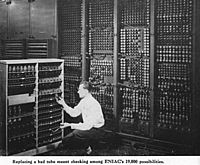
Photo from wikipedia
Using a Wizard-of-Oz approach, we explored the effectiveness of engaging drivers in conversation with a digital assistant as an operational strategy to combat the symptoms of passive task-related fatigue. Twenty… Click to show full abstract
Using a Wizard-of-Oz approach, we explored the effectiveness of engaging drivers in conversation with a digital assistant as an operational strategy to combat the symptoms of passive task-related fatigue. Twenty participants undertook two 30-minute drives in a medium-fidelity driving simulator between 13:00 and 16:30, when circadian and homeostatic influences naturally reduce alertness. Participants were asked to follow a lead-car travelling at a constant speed of 68mph, in a sparsely-populated UK motorway scenario. During one of the counterbalanced drives, participants were engaged in conversation by a digital assistant (‘Vid’). Results show that interacting with Vid had a positive effect on driving performance and arousal, evidenced by better lane-keeping, earlier response to a potential hazard situation, larger pupil diameter, and an increased spread of attention to the road-scene (i.e. fewer fixations concentrated on the road-centre indicating a lower incidence of ‘cognitive tunnelling’). Drivers also reported higher levels of alertness and lower sleepiness following the Vid drive. Subjective workload ratings suggest that drivers exerted less effort to ‘stay awake’ when engaged with Vid. The findings support the development and application of in-vehicle natural language interfaces, and can be used to inform the design of novel countermeasures for driver fatigue.
Journal Title: Iet Intelligent Transport Systems
Year Published: 2018
Link to full text (if available)
Share on Social Media: Sign Up to like & get
recommendations!